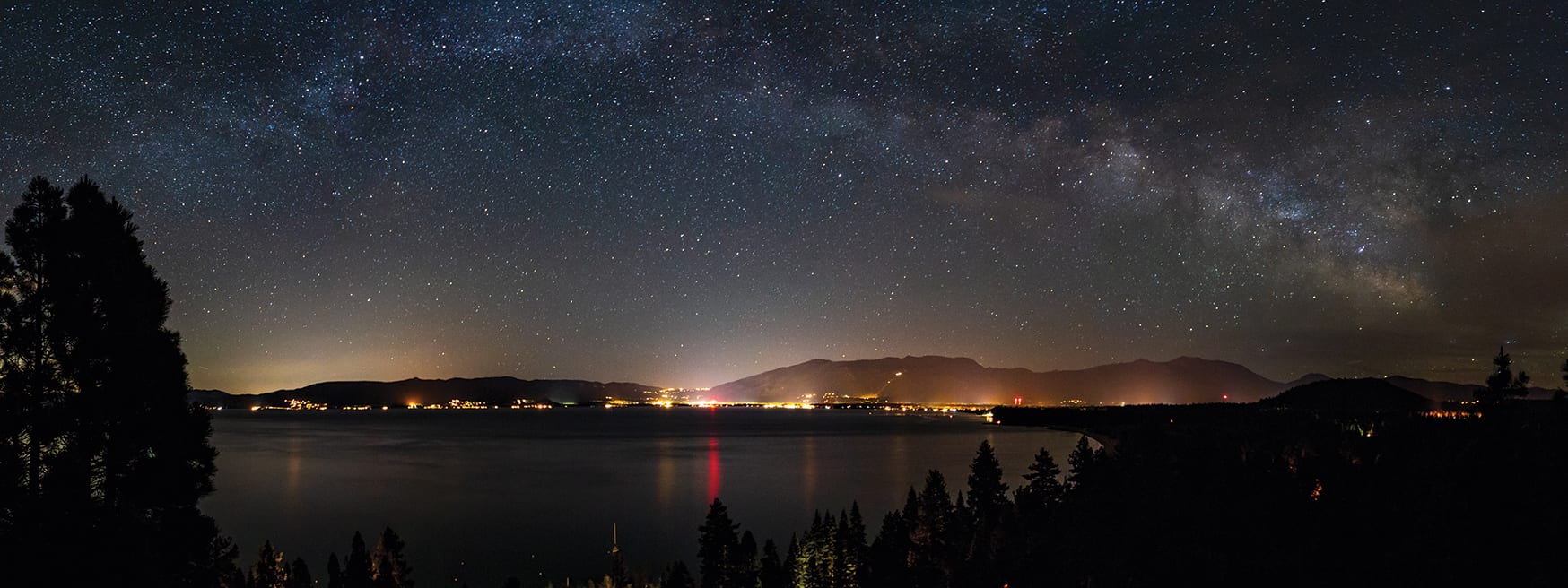
25 Jun A Clean Path to the Future
Tahoe-Truckee residents want renewable energy. Now, how do we get it?
Every seat was taken at the Town Council meeting in Truckee last November. The item on the agenda—a resolution for 100 percent renewable energy—was universally supported. Even in small towns, where roundabouts versus stoplights have potential to divide neighbor from neighbor, renewable energy feels like something everyone can get behind.
Following the lead of South Lake Tahoe, which made its own commitment to renewables eight months prior, the Truckee Town Council pledged that every electric wire within its jurisdiction would be powered by clean, renewable energy by 2030. After the sitting mayor, Morgan Goodwin, signed the resolution, the news was celebrated with fanfare. The Sierra Club touted Truckee as the 50th city in the United States to sign on for renewable energy and another win for a growing grassroots movement built to disrupt fossil fuels and fight climate change.
“Every time a local government like Truckee adopts a 100 percent resolution, that’s an expression of political will for action on climate change that reverberates beyond Truckee,” says Deirdre Henderson, co-chair of the citizen-led 100 Percent Renewable Truckee Coalition. “It’s about building a path to the future.”

Deirdre Henderson
We are living in a watershed moment for renewable energy, but a year since these promises sprouted, the road maps to reach 100 percent renewable energy remain vague and considerably different for each group.
While Vail Resorts (including Heavenly, Northstar, and Kirkwood) made a certified Epic Promise to operate with a net zero carbon footprint by 2030, Squaw Valley Alpine Meadows claimed its lifts could be spinning on renewable energy as early as December. In South Lake Tahoe, the school district is looking to convert half its bus fleet to electric within three years, and a request for proposal was just completed for a solar array at the South Lake Tahoe Airport.
But without an official sustainability department, the City of South Lake Tahoe’s efforts rely heavily on a group of volunteers. It’s the same in Truckee, where a group of volunteers are navigating the town’s dizzying array of government agencies and independent districts, each with its own board and set of priorities.
“There is a ton of great well-meaning grassroots support, and the committees include experts in the field who understand the complexities of these issues,” says Steve Frisch, the president of the Sierra Business Council, which has been deeply involved in the renewable energy policy, advocating for Sierra Nevada communities at the state level.
From this vantage, Frisch says the 100 percent renewable goals are laudable, if complicated. Smart solutions must be found to expand solar, wind and biomass, develop technology to store all that energy, and finance these new projects while keeping rates affordable and the grid reliable. As well, Frisch points out that, while Truckee–Tahoe has universally converted to natural gas, many rural parts of the Sierra still rely on propane. As daunting as this sounds, Frisch says it’s “probably achievable.”
“What these movements are doing is highlighting to local jurisdictions, we want you to do this and, by the way, you have 20 years,” says Frisch.
In Tahoe and Truckee, a handful of doggedly optimistic people believe that renewable energy is not the only answer to solving climate change, but a means of taking action.
“It’s just like life,” says Nick Exline, a land-use planner and chair of the South Lake Tahoe 100 Percent Renewable Energy Committee. He also founded the Tahoe Climate Change Action Network. Exline was watching a documentary about climate change and renewable energy when his carpets were getting cleaned. It dawned on him that if he was going to get involved, it was going to be now.
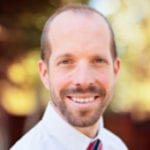
Nick Exline
“I went paddleboarding with my dog and got the determination that this is what I was going to do,” he says. So, in 2016, he ran for the board of the South Lake Tahoe sewer and water utility district on a platform of climate change and renewable energy. He lost the election, but he started building momentum that eventually led to the city’s renewable energy resolution.
“You just have to know the direction you want to go in and start walking that road,” says Exline. “Because if you wait until you know everything, you will never be able to take that first step.”
Complicating Matters
Five months after the Town of Truckee declared its goal, at another public meeting, the tone was different. This time, the town’s electric utility, the Truckee Donner Public Utility District (TDPUD), which operates independently from the Town Council, had on the agenda whether to add nuclear to its portfolio.
“My initial reaction was—nuclear?” says Erin de Lafontaine, a financial analyst who used to work at Sierra Pacific Power Company (now NV Energy.) Now, Lafontaine volunteers as a co-chair of Truckee’s committee with Henderson. “We had to scurry. Everyone’s first step was to learn more about the technology.”
This was not the first time the community took up an issue with the TDPUD. In 2006, answering to local outcry, the board voted down an equity share contract with a coal plant. The pivot put the public utility on track to source clean, renewable energy—with a focus on building a diverse, resilient portfolio of electric resources—long before the Town Council passed its own resolution in November. Twelve years later, 65 percent of their grid is hooked up to clean, renewable energy.
“We love 100 percent goals, and we’re one of the greenest utilities in California,” says Steven Poncelet, TDPUD’s legislative and regulatory affairs director. “We have some of the lowest rates and we’ve invested heavily in system reliability. But I can tell you, the first third is pretty easy. The second third you can get your mind around. The last third you can’t make it up anymore.”
Nuclear, technically, is clean energy. It does not emit carbon. The U.S. Department of Energy says that small modular reactors, like the one the TDPUD was considering in Idaho Falls, are key to “safe, clean and affordable” nuclear power, with better containment and safety standards than traditional, larger reactors. The price was competitive, says Poncelet, and the utility needs a power source that is a carbon-free, reliable, base-load resource to turn up and down when wind and solar farms aren’t generating energy. Natural gas is propping up the grid today.
“Nuclear is a difficult issue because lowering carbon emissions is really the name of the game,” says Henderson. A lawyer, Henderson was in the process of starting a chapter of the Citizen’s Climate Lobby in Truckee in July 2017 when President Donald Trump made the announcement that the United States was pulling out of the Paris Accord. Her volunteer work with the Climate Lobby led her to co-chair Truckee’s renewable energy committee.
“Many people who are passionate about climate change really think seriously about nuclear as a potential part of the energy mix for the future. But a contrary group of experts believe we can achieve 100 percent renewable electricity without nuclear,” says Henderson. “We can do it with all of the natural renewables that don’t produce that kind of toxic waste, and we are betting on that scenario.”
Nuclear comes from Uranium. Unlike classified renewables such as wind and solar, it does not replenish in a short period of time. It also generates waste, which ultimately was the tipping point that led the TDPUD to vote against the project.
“It’s about local control,” says Poncelet. Founded in 1927, the TDPUD answers to a locally elected board and serves 14,500 customers. “People didn’t like the fact that we were considering small modular reactors in their desire to get to carbon-free, so they showed up and interacted with our board and their voices were heard.”
As much as Poncelet says he respects and supports the town’s aspiration, the technology is not there—at least not yet—to get to 100 percent renewable energy in a way that keeps rates affordable and reliability solid, especially during Truckee’s peak energy-using hours around 6 p.m. each day between Christmas and New Years.
“My joke is, we did a study and over the last million years, the sun has never shown at 6 p.m. in the middle of winter. These are the realities we have to deal with,” says Poncelet. “I’d love to get there. I think it’s an admirable goal and aspiration. I think that if we could do it today with stable rates and maintain the reliability, we would. But the devil is in the details. We’re the ones who have to send the bills out—to everybody. Not just the people who want [renewable energy]. That’s the challenge for sure.”
The Town of Truckee installed solar street lights as part of its renewable energy commitment, photo by Sylas Wright
Renewable Demands
Renewable energy comes from a source that is inexhaustible, like the sun and wind. These resources are abundant, especially in the West. Yet the United States, history’s largest emitter of carbon, has burned fossil fuels for power since the Industrial Revolution in the late 1700s, which has contributed to climate change and a 2-degree Fahrenheit rise of Earth’s average surface temperature, according to NASA. Most of that warming happened in the last 35 years.
Here in the Sierra Nevada, the stakes of climate change are plain. We live at the top of a watershed that serves 23 million people. The snow is most vulnerable between 5,000 and 8,000 feet elevation. If nothing is done to stop climate change, a UCLA study predicts springtime temperatures will rise 7 degrees by the end of the twenty-first century. The snowpack will drop 64 percent, on average, and winters will become more volatile, swinging between extremes. Snowmelt runoff will happen 50 days earlier. It’s not just the environment that climate change threatens to disrupt. A 2018 report from Protect Our Winters says that low snow years have such a negative impact on the ski industry, it costs the U.S. economy more than $1 billion and 17,400 jobs.
Worldwide, renewables are growing faster than any other energy source, according to a report published in March 2018 by the International Energy Agency. Last year, they accounted for 25 percent of global electricity generation. This is encouraging news. And yet, carbon continues to jet into the atmosphere and warm the planet. The same report sounded alarms, reporting that a historic 32.5 gigatonnes of carbon emissions were released into the atmosphere in 2017. The demand for energy across the planet increased by 2.1 percent, and 72 percent of that rise was met by fossil fuels. Still, public demand for renewable energy is changing how utilities do business.
Liberty Utilities serves electricity to 49,000 customers in a grid that hugs the California side of the Nevada border, from Portola in the north to Walker in the south, including the Tahoe Basin and the unincorporated outskirts of Truckee. Their portfolio already clocks in with 25 percent renewable energy, thanks to the 50-megawatt Luning Energy solar plant located down Highway 95, a lonely road in Nevada between Reno and Las Vegas that Governor Brian Sandoval said would become the state’s “Electric Highway.” Another 10-megawatt solar facility near Reno is in the works. When that comes online, Liberty will generate enough renewable energy to account for 30 percent of its electricity.
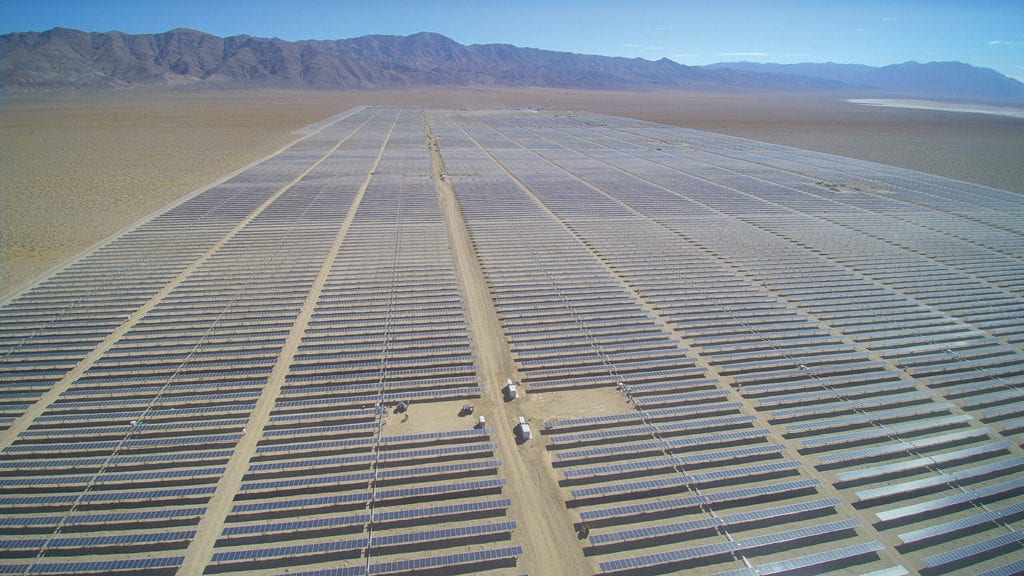 Liberty Utilities already uses 25 percent renewable energy thanks to its 50-megawatt Luning Energy solar generation plant on Highway 95 in Nevada, photo courtesy Liberty Utilities
Liberty Utilities already uses 25 percent renewable energy thanks to its 50-megawatt Luning Energy solar generation plant on Highway 95 in Nevada, photo courtesy Liberty Utilities
“Up and down the company, there is a commitment to renewable energy,” says John Friedrich, Liberty Utility’s business and community manager for the Tahoe region. “It’s on principle. We need to take action on climate change and our company acknowledges that, so therefore, we need a rapid transition to renewables. That’s what our customers are demanding. The cost has come down to make it a smart economic decision for our company to make.”
California generates more solar power than any other state—21 gigawatts, according to the Solar Energy Industries Association. (North Carolina ranks second, with 4.3 gigawatts of installed solar.) And that figure will continue to skyrocket. Last month, the California Energy Commission voted unanimously that all new houses must have solar panels. The commission predicts the new regulation will increase building costs by $9,500, but it will save homeowners $19,000 in energy and maintenance over 30 years.
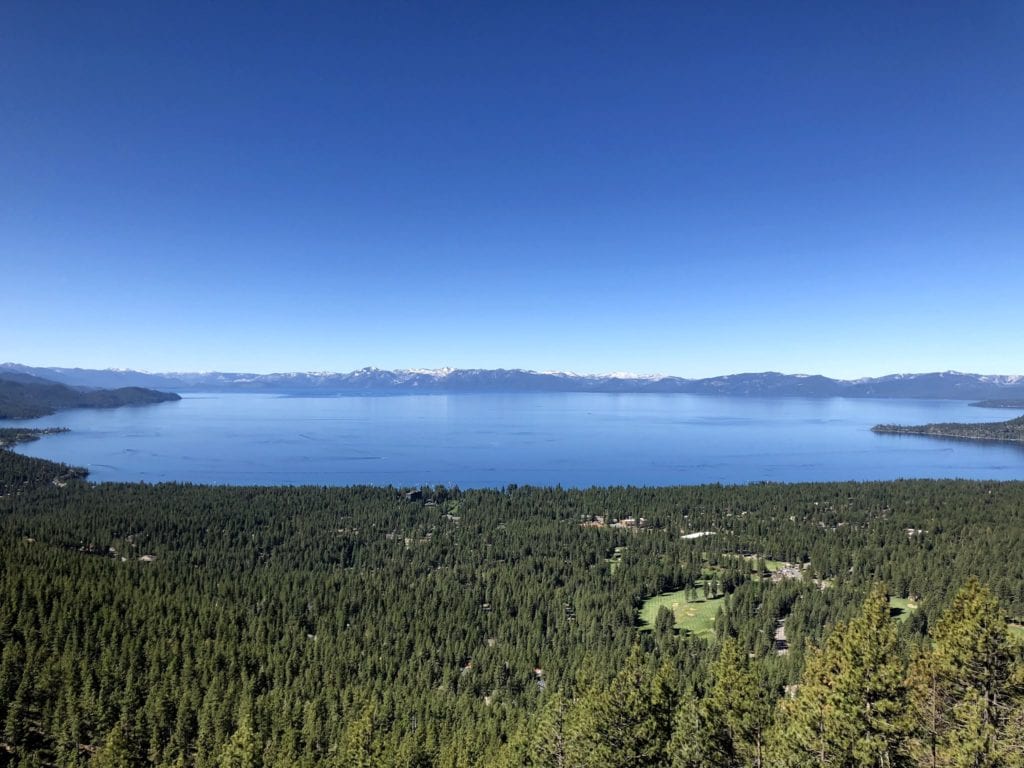 Despite a boom in solar, the technology to store all the clean energy produced from natural sources like the sun is lacking, photo by Clayton Humphries
Despite a boom in solar, the technology to store all the clean energy produced from natural sources like the sun is lacking, photo by Clayton Humphries
Storing Power
Yet, battery storage and technology need to catch up with the solar explosion. In fact, California has so much solar, and no place to store it, that it has threatened to surge and shut down the grid in years past. In 2017, the LA Times reported the state was forced to sell some of its solar to Arizona to avoid overloading its power lines.
The California Independent System Operators (ISO), an agency that manages 80 percent of the electricity lines in the state, recently forecasted an energy shortage during summer’s peak hours. When people come home from work, it’s hot, so they turn on air conditioning, and the sun has set, so solar is not generating. The California ISO says the state’s hydroelectric power will be “tight” during high-load periods this summer, “especially during evening hours of hot days when solar power dissipates.”
“It’s complicated because you have to keep the lights on,” says Poncelet. He says batteries are the Holy Grail question. Storage would save the solar industry, and wind and hydro, too, because it would help utilities manage demands during peak hours.
Batteries are key to the microgrid proposed at Squaw Alpine. Announced last winter, Liberty Utilities has proposed to the California Public Utilties Commission and Placer County building and operating a storage system of Tesla batteries large enough for 8 megawatts of power at a mid-mountain facility near Gold Coast. The microgrid would store enough energy to serve residents and businesses in Olympic Valley, including the ski resort.
“Batteries can be a complementary resource,” says Friedrich. “Solar generation by day, discharge at night. It’s both an energy source and a backup power source.” Liberty has also submitted an application to the California Public Utilities Commission to build a similar battery energy storage system in Markleeville, located in Alpine County south of Tahoe.
To hook up Squaw Alpine to renewable energy by the time lifts start spinning this winter, Friedrich says they are also discussing a green tariff. It’s a premium rate that gives customers like Squaw Alpine priority for the renewable energy currently in Liberty’s portfolio. In turn, the tariff gives Liberty extra cash to invest back into building new renewable resources. “It’s like a down payment on new renewables,” says Freidrich. The TDPUD is also looking into a tariff so that customers who want clean, green electricity can pay for it.
The tariff is one of several programs Liberty offers to support renewable energy aspirations. The utility incentivizes rooftop solar, audits homes for energy efficiency and is planning to scale up electric vehicle infrastructure, like at the South Lake Tahoe School District for its fleet of new electric buses.
“This is not a pipe dream,” says Friedrich. “Communities should see utilities as a real partner in meeting these goals.”
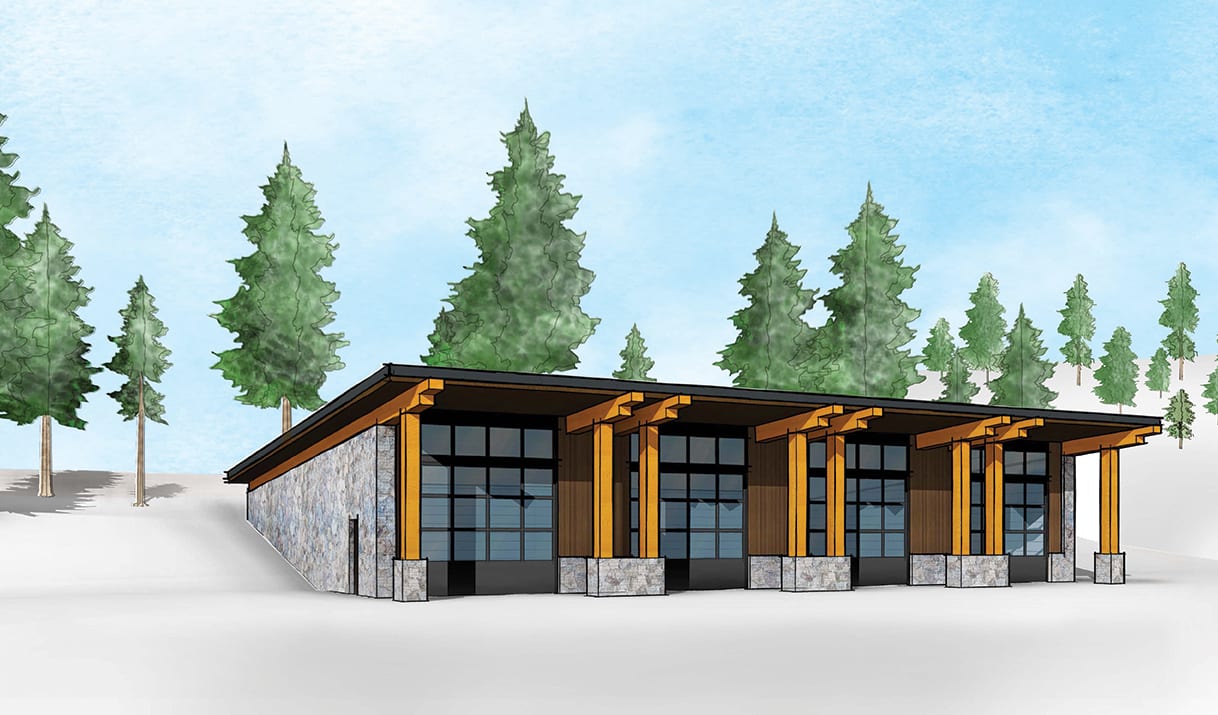 The proposed Olympic Valley Microgrid would be located in a mid-mountain facility near Squaw Valley’s Gold Coast, courtesy Squaw Valley Alpine Meadows
The proposed Olympic Valley Microgrid would be located in a mid-mountain facility near Squaw Valley’s Gold Coast, courtesy Squaw Valley Alpine Meadows
Footing the Bill
The costs, though, are inevitably passed down to the ratepayers. Where the California Public Utility Commission regulates investor-owned utilities like Liberty to monitor rates and approve projects, the TDPUD keeps rates down by aggregating their resources with a group of about 70 small public power utilities called the Utah Associated Municipal Power Systems (UAMPS).
Together, these utilities can bid on large projects, like the 57.6-megawatt Horse Buttes wind farm, a heat recovery project, a landfill gas project, small hydro and more wind from another farm in Utah. They are also looking for storage and batteries, but Poncelet says the cost is prohibitive by an “order of magnitude more,” noting that unsolved waste is also an issue for batteries. Even though prices for wind and solar have come down significantly, the dollar figure for Truckee would be “significantly higher” compared to the rates behemoth energy giants could negotiate. “It’s like New Moon trying to get the same prices as Walmart,” says Poncelet.
“It’s great to say I want 100 percent and I’m rich and I can afford it. We’re super psyched we’re at 67 percent, but we’re not going to get to 100 if it means our rates become so unaffordable that nobody can live here,” Poncelet adds.
Truckee may be a place where wealthy people visit, but it’s not a wealthy town. The 2016 median household income was pushing $80,000. The town’s median home value is almost $600,000.
“Saying [renewables] ‘are cheap, let’s just get it,’ might solve your individual problem, but this is a societal issue,” says Poncelet. “Just like greenhouse gases are.”
From Talk to Action
Last year, Exline walked into a meeting with a dozen senior staff of South Lake Tahoe’s casinos to talk about renewable energy and climate change. He got a lot of uncertain stares. He told them: “I want you to remember that we had this conversation, so when the opportunity presents itself and policies come forward, you have someone you can contact, you understand the economic benefits, the environmental benefits.”
He hasn’t heard back from any of the casinos on the South Shore—yet. But casinos in Las Vegas have donated millions to campaign in favor of a state energy bill on ballots in November that will deregulate Nevada’s grid and, proponents say, trigger an explosion of private investment in solar and wind.
Exline muses that, with a deregulated grid in Nevada, each glittering casino could potentially become its own renewable energy utility. But right now, that’s a pipe dream.
“It’s one of the least sexy times, unfortunately,” says Exline. Then again, he adds, South Lake Tahoe could break ground on a solar array at the airport this year.
“Don’t get hung up on every step in how you get there,” says Exline. “When we collaborate, that’s what creates the change. We have to start to understand things in that context, that we, as a group, can change things and make things better through hard work. The hope exists.”
Julie Brown grew up on Tahoe’s West Shore and cut her teeth reporting at local newspapers. She is an editor at POWDER magazine and her work has published in Outside and ESPN. Also, skiing makes her happy.




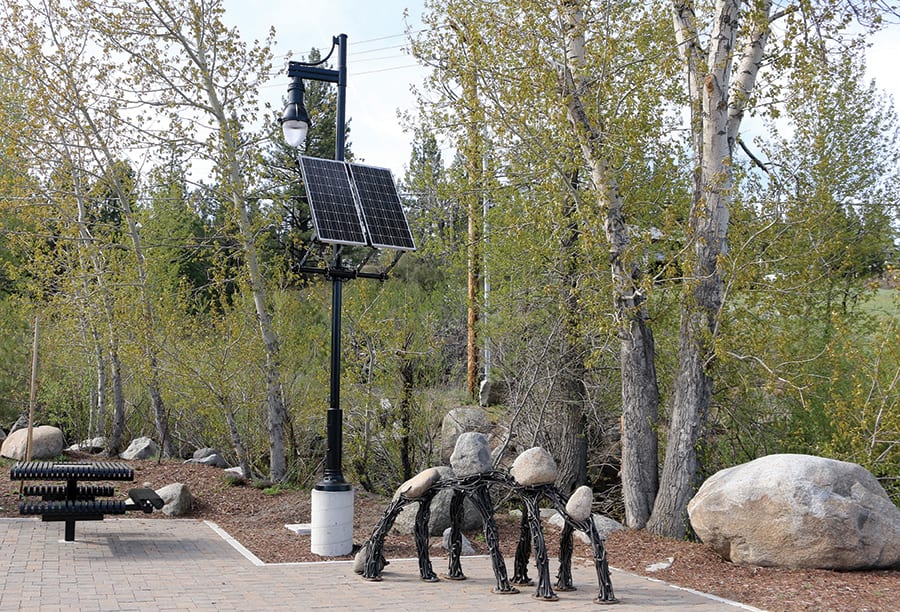
No Comments